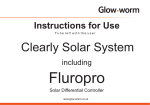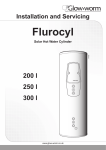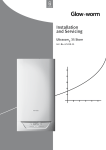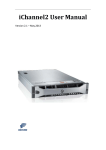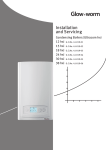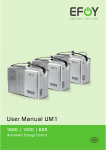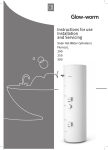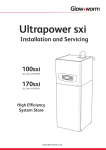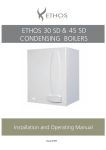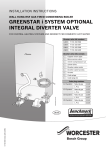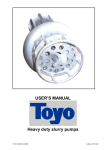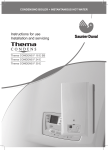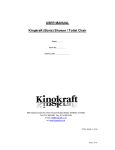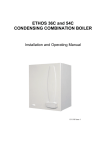Download Clearly Solar System Hydraulics - Manual Operation - Glow-worm
Transcript
Clearly Solar Installation and Servicing System Hydraulics including Solar Pump Station and Accessories www.glow-worm.co.uk 1 Guarantee Registration Thank you for installing a new Glow-worm solar system. Glow-worm products are manufactured to the very highest standard so we are pleased to offer our customers a Comprehensive Guarantee. This product is guaranteed for 24 months from the date of installation or 30 months from the date of manufacture, whichever is the shorter, for parts and labour. The second year of the guarantee, from the beginning of the 13th month onwards after installation or manufacture, is conditional upon the product having been serviced by a competent person (i.e. clear skies registered engineer), in accordance with the manufacturer’s recommendations. We strongly recommend regular servicing of your product, but where the condition is not met, any chargeable spare parts or components issued within the applicable guarantee period still benefit from a 12 month warranty from the date of issue by the manufacturer. The “Benchmark” Installation, Commissioning and Service Record must be completed on installation and kept up to date. We recommend you complete and return as soon as possible your guarantee registration card. If your guarantee registration card is missing you can obtain a copy or record your registration by telephoning the Glow-worm Customer Service number 01773 596510. Customer Service: 01773 596510 Technical Helpline: 01773 828300 General and Sales enquiries: Tel. 01773 824639 Fax: 01773 820569 To register your Glow-worm product call: 0800 0732142 Benchmark places responsibilities on both manufacturers and installers. The purpose is to ensure that customers are provided with the correct equipment for their needs, that it is installed, commissioned and serviced in accordance with the manufacturer’s instructions by competent persons and that it meets the requirements of the appropriate Building Regulations. The Benchmark Checklist can be used to demonstrate compliance with Building Regulations and should be provided to the customer for future reference. Installers are required to carry out installation, commissioning and servicing work in accordance with the Benchmark Code of Practice which is available from the Heating and Hotwater Industry Council who manage and promote the Scheme. Visit www.centralheating.co.uk for more information. 2 These instructions consist of, Installation, Servicing, Fault Finding. The instructions are an integral part of the product and must be handed to the user on completion of the installation. CONTENTS DESCRIPTION SECTION PAGE INTRODUCTION Warnings Important Information Statutory Requirements Notes on the Documentation Safety Instructions INSTALLATION System Specifications Product Specifications Component Specifications Installation Commissioning Commissioning Checklist Commissioning Data 1 2 3 4 5 6 6 7 8 9 11 16 18 19 MAINTENANCE Inspection and Maintenance Fault Finding Solar Fluid Safety Data 7 8 9 21 22 25 3 4 4 5 6 6 WARNINGS SAFETY The system must be installed by a competent person, who is responsible for adhering to the existing standards and regulations. ALTERATIONS Under no circumstances should you ever attempt to make alterations to these components or any other part of the system SEALED COMPONENTS Under no circumstances must the user interfere with or adjust sealed parts. Important Information Installation and Use Regulations CE Mark In your own interests and that of safety, it is the LAW that this product is installed by a competent person in accordance with the current issue of these regulations. The CE mark on this product indicates that it complies with the basic requirements of the applicable directives as stated on the data badge. Local authority planning permission may be required for the installation. The local authority should be notified. “Benchmark scheme” Glow-worm support the Benchmark initiative. It is very important that the service record is completed by the installation engineer and handed over to the user. Control of Substances Hazardous to Health Under Section 6 of The Health and Safety at Work Act 1974, we are required to provide information on substances hazardous to health. The adhesives and sealants used in this product are cured and give no known hazard in this state. Solar fluid safety data, see section 9. Manual Handling With regards to the “Manual Handling Operations, 1992 Regulations”, the appliance exceeds the recommended weight for a one man lift, refer to section 9 for more information. Electrical Supply The product MUST be earthed. All system components shall be of an approved type and all wiring to current I.E.E. wiring regulations. External wiring must be correctly earthed, polarised and in accordance with the relevant standards. In GB, this is BS 7671. In IE, this is the current edition of ETCI rules. The product MUST be connected to a permanent 230V ac, 50Hz supply. Testing and Certification This product is tested and certificated for safety and performance. It is, therefore, important that no alteration is made to the product, without permission, in writing, by Glowworm. Any alteration not approved by Glow-worm, could invalidate the certification, warranty and may also infringe the current issue of the statutory requirements. 4 Statutory Requirements IMPORTANT Collectors and collector assembly Where no British Standards exists, materials and equipment should be fit for their purpose and of suitable quality and workmanship. ENV 1991-2-4 Eurocode 1 – Basis of design and actions on structures - Part 2–4: Actions on structures - Wind actions Solar cylinder and cylinder installation The installation of this product must be carried out by a competent person in accordance the rules in force in the countries of destination. Pressure equipment directive 97/23/EC Directive of the European Parliament and Council from 29th May, 1997 for the approximation of the laws on pressure equipment of the Member States Manufacturer’s instructions must not be taken as overriding statutory requirements. EN 12977-3 Thermal solar systems and components; Custom built systems, Part 3: Performance characterisation of stores for solar heating systems Statutory Requirements In GB, the installation of the product must be carried out by a competent person as described in the following regulations: EN 12897 Water supply - specification for indirectly heated unvented (closed) storage water heaters The manufacturer’s instructions supplied. EN 806-1 Specifications for installations inside buildings conveying water for human consumption - Part 1: General The appropriate Buildings Regulations either The Building Regulations, The Building Regulations (Scotland),The Building Regulations (Northern Ireland). EN 1717 Protection against pollution of potable water installations and general requirements of devices to prevent pollution by backflow The Water Fittings Regulations or Water byelaws in Scotland. The Health and Safety at Work Act, Control of Substances Hazardous to Health (COSHH). EN 60335-2-21 Safety of household and similar electrical appliances; Part 2: Particular requirements for storage water heaters (hot water cylinders and hot water boilers) (IEC 3352-21: 1989 and supplements 1; 1990 and 2; 1990, modified). The Current I.E.E. Wiring Regulations. Where no specific instructions are given, reference should be made to the relevant British Standard Code of Practice. Lightning protection In IE, the installation must be carried out by a competent person and installed in accordance with the current edition of I.S.813 “Domestic Gas Installations”, the current Building Regulations and reference should be made to the current ETCI rules for Electrical Installation. ENV 61024-1 Protection of structures against lightning – Part 1: General principles (IEC 1024-1: 1990; modified) BS 6651 Code of practice for protection of structures against lightning. GB: the following Codes of Practice apply: Regulations in Great Britain BS4814, BS6798, BS5440 Part 1 and 2, BS5546 Part 1, BS5449, BS6891, BS6700, BS7074 Part 1 and 2, BS7593, BS7671. Building Regulation, dating from 1991 (England and Wales) Requirement G3, L1 and Regulation 7 IE: I.S.813, BS5546, BS 5449, BS 7074, BS 7593. BS 7671 Requirements for electrical installations (IEE Wiring Regulations, 16th edition) Solar system in general BS 6759-1 Directive for the usage of the safety assembly for hot water cylinders. EN ISO 9488 Thermal solar system and components, terminology (ISO/DIS 9488; 1995) EN 12975-1 Thermal solar systems and components; Collectors, Part 1: General requirements EN 12975-2 Thermal solar systems and components; Collectors; Part 2: Test methods ENV 1991-2-3 Eurocode 1 – Basis of design and actions on structures, Part 2–3: Actions on structures - Snow loads EN 12976-1 Thermal solar systems and components; Factory made systems - Part 1: General requirements EN 12976-2 Thermal solar systems and components; Factory made systems - Part 2: Testing methods ENV 12977-1 Thermal solar systems and components; Custom built systems, Part 1: General requirements ENV 12977-2 Thermal solar systems and components; Factory made systems, Part 2: Testing methods ISO 9459-1: 1993 Solar heating – Domestic water heating systems – Part 1: Performance rating procedure using indoor test methods ISO/TR 10217 Solar energy – Water heating systems – Guide to material selection with regard to internal corrosion 5 Notes on the Documentation Notes on the documentation Other applicable documents Your solar system is a quality product from Glow-worm. Collector installation instructions. This manual covers the solar system, excluding the cylinder and provides you with information on installation, commissioning, maintenance and fault finding. It is supplemented by the installation instructions of the individual components. System hydraulic installation instructions. Observe the manuals for each individual system component in conjunction with this manual. Installation instructions for all sub components and accessories used. Warranty card. System electrical installation instructions including Fluropro. System user instructions including Fluropro. Installation and user instructions for the boiler. Look after this manual and pass it on to the user for safe keeping. Please observe the safety instructions in this manual when installing this solar system. Glow-worm accepts no liability for any damage caused by failure to observe this manual. Safety Instructions Safety instructions IMPORTANT: A thermostatic mixing valve must be fitted to the outlet of the cylinder and can be adjusted to the desired domestic hot water temperature by an installation or service engineer. Otherwise there is a risk of scalding as the cylinder outlet temperature at the taps could be up to 85°C. The entire solar system must always be installed and operated in accordance with recognised technical standards. IMPORTANT: Risk of falling! Make sure you adhere to the valid work protection regulations, in particular when working on the roof. Make absolutely sure you wear anti-fall devices whenever there is a risk of falling. (We recommend Glowworm fall protection systems, item no. 0020054985.) Observe the accident prevention regulations of the trade associations. IMPORTANT: Risk of being burned or scalded by escaping hot steam! Steam can escape from unblocked automatic bleeders if the system is shut down. Therefore block all automatic bleeders after bleeding. We recommend using the automatic air separator system supplied as part of Glow-worm optional pipework kit. It works fully automatically and does not need to be subsequently blocked. It must be installed in an area however, in which no steam can enter, preferably in the return pipe nearby the solar cylinder. IMPORTANT: Risk of being burned or scalded by hot components! Install and replace collectors or collector parts on very cloudy days. Perform installation work on sunny days only in the morning or evening or with the collector covered. IMPORTANT: Risk of being burned or scalded by hot solar fluid or components! Fill and flush the solar system when the collectors are cold. Cover the collectors while doing so. IMPORTANT: Risk of being burned or scalded by escaping hot steam! Steam can escape from the expansion relief valve of the solar pump unit if the system is shut down. To avoid injuries, you must connect the expansion relief valve to a collecting container with a hose line. 6 1 System Specifications 1.1 Intended use The solar system is used for the solar-supported supply of DHW. Any other use is considered to be improper. The manufacturer / supplier is not liable for any resulting damage. The user alone bears the risk. Intended use includes the observance of the system description and all other applicable documents, as well as adherence to the maintenance and inspection conditions. IMPORTANT: We accept no liability for any damage or injuries caused by failure to observe this manual. At the end of this manual is a commissioning protocol, which should be filled in by the installer and/or commissioning engineer and handed over to the user. 1.2 Design and function of the solar system The solar system consists of four main components: The collectors, which absorb the solar radiation and utilise it. The solar control, which monitors, displays and controls all functions of the system. The solar pump unit, which transports the solar heat. The solar cylinder. The solar collector transforms solar energy into heat and transfers the heat energy to a frost-protected solar fluid. The solar pump of the solar pump unit ensures the heat is transported from the collector to the twin coil solar cylinder via a pipe system. The solar pump unit is controlled by the solar control. The solar control switches the solar pump on or off as soon as the difference in temperature between the collector and solar cylinder falls below or exceeds the preset value. If the solar energy is insufficient, the control system switches on the boiler so that the upper third of the cylinder is reheated to the set value for the domestic hot water temperature. In addition the solar cylinder can be reheated by the immersion heater installed by the manufacturer. The solar expansion vessel compensates pressure fluctuations in the solar circuit. On days on which the solar radiation is insufficient to heat the DHW in the cylinder, the stored water must be reheated by a heating system. This can be done with boilers or electrically with an immersion heater. The optional protection vessel protects the expansion vessel from increased temperatures in the solar circuit. We recommend installing a protection vessel. Local authority planning permission may be required for the installation. The local authority should be notified about the intended installation. The solar system is a closed system and must be bled carefully. We recommend the automatic air separator system for this purpose (item no. 0020054969). It works fully automatically and does not need to be subsequently blocked. The automatic air separator system must be installed in an area in which no steam can enter, preferably in the return pipe between the solar pump unit and the solar cylinder. 7 14162 2 Product Specifications Clearly Solar Collector Solar Pump Unit Flow DHW 2 Port Valve M Protection Vessel Solar Expansion Vessel Return Flurocyl Immersion Heater Drinking Water Expansion Vessel Automatic Air Separator System Boiler Flow Return M 2 Port Valve Diagram 2.1 2.1 Diagramatic view of the system installation Refer to diagram 2.1 8 3 Component Specifications 250 2 120 6 Ø 22 Solar Pump Station part no. 0020054961 14829 7 5 Ø 22 3 358 1 Ø 22 Ø 22 Ø 22 Ø 22 4 SOLAR EXPANSION VESSEL CONTAINER Item Qty. Description 1 1 Flow tube with isolating valve with integrated gravity brake and temperature display 2 1 Return tube with isolating valve with integrated gravity brake and temperature display, flow rate meter with fill/vent valve, circulating pump 3 1 Safety valve with pressure gauge, fill valve and corrugated tube DN16 including wall bracket for solar expansion vessel 4 1 Wall bracket for expansion vessel with fitting 5 1 Wall bracket for solar pump station 6 4 22mm Compression nuts 4 22mm Brass olives 4 22-18mm Reducers (discard) 2 C-clips 7 Solar Expansion Vessel Diagram 3.1 3.1 Solar pump station Refer to diagram 3.1 for contents and description. The solar pump unit is equipped with a three-speed solar pump for the optimum adaptation of the required circulating volume and the pump capacity in the solar circuit. Select the pump capacity, depending on the solar system (e.g. collector surface, pipe diameter, length of the solar circuit), so that the actual flow rate is slightly higher than the nominal flow rate. The flow rate meter is used for fine adjustment of the flow rate. The solar pump unit is delivered with a water control pack, consisting of an expansion relief valve and a pressure gauge. The flow rate meter installed in the return pipe is an essential component of the solar system. To achieve optimum heat transfer, you must achieve a certain flow rate, refer to section 5.2. Upper deviations are not as serious as lower deviations. Make the rough adjustments with the solar pump first. You can make the fine adjustments with the adjustment valve of the flow rate meter. You can view the set value on the display of the flow rate meter. The flow rate meter has a fill/vent valve for filling and draining the solar circuit. NOTE: Do not under any circumstances set the flow rate below the calculated flow rate. The collector efficiency will be considerably reduced. If you would like to use the solar flexible pipework (DN16 0020054964) from the pump station to the cylinder, please order an additional two fittings packs, part No. 0020054965, these contain the relevant fittings for this application. 9 18 litre Supplied with 1 collector pack 25 litre Supplied with 2 collector packs 35 litre Supplied with 3 collector packs 3 Component Specifications 3.2 Solar expansion vessel 3.3 Thermal cut out of the solar pump The solar expansion vessel, is used to equalise the pressure while the pressure relief valve blows off the solar fluid into the collecting container via the pressure release pipe if the operating pressure of 6 bar is exceeded. The solar pump must be protected by its own thermal cut out (TCO) which must be mounted on the solar cylinder (preassembled at the factory on the Glow-worm Flurocyl cylinder). The power supply to the pump MUST be interrupted at cylinder temperatures higher than 90°C. The size of the solar expansion vessel is based on the expansion volume of the solar system. 3.4 Solar fluid The expansion vessel not only accommodates the expansion volume of the solar fluid, but also the entire volume of the collectors in the event of a shutdown. The total volume of the solar system is the total of the individual values of the collector, heat exchanger volume and the volume of the pipeline. This information applies to Glow-worm solar fluid (20 l canister: item no. 0020054968). Glow-worm solar fluid is a ready-mixed antifreeze and anticorrosive, consisting of approximately 45% propylene glycol with anti-corrosion inhibitors and 55% water. It is resistant to high temperatures. The admission pressure of the solar expansion vessel can be set between 0.5 and 4.0 bar. Component Volume (l) Flurocyl 200 l heat exchanger solar circuit 3.04 Flurocyl 250 l heat exchanger solar circuit 3.04 Flurocyl 300 l heat exchanger solar circuit 4.14 Flurocyl 200 l heat exchanger reheating circuit 3.7 Flurocyl 250 l heat exchanger reheating circuit 3.7 Flurocyl 300 l heat exchanger reheating circuit 3.7 Solar pump unit 0.9 Vertical solar thermal flat plate collector 1.85 Horizontal solar thermal flat plate collector 2.16 Protection vessel 5.0 Furthermore the solar fluid has a high thermal capacity. The inhibitors provide reliable corrosion prevention when using different types of metal (mixed installations). NOTE: Do not use any other anti-freeze or inhibitors with the collector. Only Glow-worm solar fluid is approved. IMPORTANT: Risk of damage! Glow-worm solar fluid is ready mixed. You may not under any circumstances mix it with water or other fluids. Otherwise it will become ineffective as an antifreeze or anticorrosive, resulting in damage to collectors or other parts of the system. Glow-worm solar fluid is infinitely durable in hermetically sealed containers. Skin contact is normally not dangerous. Eye contact only causes minor irritations, you should nevertheless immediately wash your eyes. Observe the safety data sheet, see section 9. Table 3.2 Volume of individual circuits 3.5 Protection of the solar circuit against frost and corrosion To protect the solar system reliably against frost in winter, the entire solar circuit must be filled 100% with solar fluid. NOTE: You can achieve frost resistance of about -28°C by filling the solar system with Glow-worm solar fluid. No damage is caused by frost even at outside temperatures below -28°C, since the expansive effect of the water is reduced. Check the antifreeze effect after filling the system and then once a year. To check the solar fluid; refer to the operating manual of the solar fluid tester (item no. 0020054984). 10 4 Installation 14172 Make sure that you have all the components required, see diagram 4.1, 4.2 and tables 4.1 and 4.2, below. 4.1 Recommended installation sequence Assuming that the cylinder and collectors are fitted with the exception of the solar system hydraulics and wiring, it is recommended that the solar pump station is now fitted followed by the solar circuit pipework. 1 The cylinder and collectors must be installed in accordance with the separate installation instructions. Proceed with the installation as described in the following sections and shown in the diagrams 4.3 and 4.4 . Item Description 1 Solar collector panel 2 On-roof, In-roof or Flat roof kit 3 Solar pump unit 4 Fluropro solar control 5 Roof bracket set, concrete tiles 6 Solar fluid (20 litre) 7 Automatic air separator 8 Expansion vessel 9 Protection vessel 2 4 3 5 9 Table 4.1 Typical solar items Item Description 1 Single insulated tube DN16 15m x 2 2 Fittings pack for DN16 tube 6 8 7 Table 4.2 Optional pipework kit Diagram 4.1 14351 Solar set items 1 Optional pipework kit items 11 2 Diagram 4.2 14213 4 Installation SOLAR COLLECTOR THERMOSTAT MIXER SOLAR COLLECTOR CIRCUIT PUMP PUMP HOT WATER CONNECTION LEGIONNELLA LOOP (optional) TEMPERATURE AND PRESSURE RELIEF VALVE (95 °C, 7 BAR) BOILER EXPANSION VESSEL FLOW RETURN MOTORISED 2 PORT VALVE EXPANSION RELIEF VALVE (6.0 BAR) PRESSURE LIMITING VALVE (3.5 BAR) WITH LINE STRAINER FLOW MOTORISED 2 PORT VALVE COLD WATER SUPPLY TUNDISH RETURN AUTO AIR SEPARATOR FLUROCYL DRAIN VALVE Diagram 4.3 12 4 Installation 14212 Collector arrays setup for East / West orientation N W E S SOLAR COLLECTOR SOLAR COLLECTOR SOLAR COLLECTOR CIRCUIT PUMP THERMOSTAT MIXER HOT WATER CONNECTION BOILER PUMP LEGIONNELLA LOOP (optional) TEMPERATURE AND PRESSURE RELIEF VALVE (95 °C, 7 BAR) EXPANSION VESSEL FLOW RETURN MOTORISED 2 PORT VALVE EXPANSION RELIEF VALVE (6.0 BAR) PRESSURE LIMITING VALVE (3.5 BAR) WITH LINE STRAINER FLOW MOTORISED 2 PORT VALVE RETURN COLD WATER SUPPLY TUNDISH AUTO AIR SEPARATOR FLUROCYL DRAIN VALVE Diagram 4.4 13 4 Installation 4.2 Fitting the solar pump station (wall-mounted installation) IMPORTANT: Use hard solder only, soft solder is NOT suitable. Do not use any plastic pipes. Fit the wall bracket and the pump station flow and return assemblies. Flexible stainless steel pipes supplied by Glow-worm or copper pipes should be used for the solar circuit. Secure the assemblies in the wall bracket using the two Cclips. Put them onto the flow and return assemblies below the wall bracket. Optional Glow-worm flexible pipes for the connection of the collectors to the solar pump unit. 0020054994: 2 in 1 flexible pipe DN 16 x 15 m 4.3 Pressure relief valve and expansion vessel 0020054964: single flexible pipe DN 16 x 15 m Fit the pressure relief valve assembly to the connection nozzle in the pump station return tube assembly. Two single flexible pipes DN 16 x 15 m are available as part of the Glow-worm optional pipework kit. Instructions for the connection of these flexible pipes can be found in separate installation instructions. IMPORTANT: Loss of solar fluid! Install a discharge pipe from the pressure relief valve outlet to a container to ensure that any hot solar fluid escaping from the system is contained. Due to the occasionally high temperatures of the solar fluid, plastic pipes must not be used for the solar circuit. Copper pipes must be joined using hard soldering or compression fittings. Soft soldering is NOT suitable. The solar fluid container is intended as a collecting container when the system is filled and the container is empty. Connect a discharge pipe from the relief valve outlet to the intended location for the container. Teflon tape can be used on pipework below the Solar Pump Station. Mount the expansion vessel wall bracket using screws and plugs. Screw the flange and the expansion vessel to the wall bracket. IMPORTANT: Earth the solar circuit! The solar pipework must be earthed in accordance with the requirements of BS 7671 IEE Wiring Regulations. Wiring protection should be provided if there is high risk of lightning strikes. The electronics in the solar system, heating system or in the house could otherwise be destroyed if they were to be hit by lightning. Connect the collectors to an existing lightning protection on the house. The expansion vessel must be mounted vertically and the flow from the system must enter the vessel from the top. To avoid accidental spillage or access by children to the fluid, best practice is to take the discharge pipe right to the bottom of (but not touching) the container. The empty solar fluid container is recommended, as reusing it helps to reduce landfill, the contents of the container are visible (you must be able to see if the safety valve has discharged) and offers a practical solution. However, if preferred, an alternative vessel may be used, provided it is of adequate size, the contents are visible and it is not fully sealed. IMPORTANT: Risk of damage to the collectors due to excessive pressure. The installation of a motorised 2 port valve in the pipes of the solar system is not allowed, since the safety devices in the solar circuit could be overridden by it. The right selection of the pipe diameters plays a significant role in terms of maximum efficiency of the solar system. 4.4 Notes on the solar circuit pipework To keep the pressure loss in the solar circuit to a minimum, the flow velocity in the copper pipe should not be higher than 1.5 m/s. When installing solar circuit pipework between the collector array and the cylinder, carefully consider the location of the pump station and the requirement for an automatic air separator. The Glow-worm solar system is a closed hydraulic system in which heat can only be transferred to the cylinder by means of special heat transfer fluid in the solar system. Observe the following points to ensure perfect operation with maximum energy utilisation: A nominal flow rate of 0.66 l/min per net m2 collector surface is required by the collectors to achieve optimum heat transfer. Another decisive criteria for the optimum operation of your solar system is the speed of the solar pump. The pump must be able to deliver more than the nominal flow rate at the specified operating pressure. The selection of the required pump speed depends on the installed system. Reference value for the pump selection can be found in section 5.2. Bleed the system completely during commissioning and servicing since air in the system has a considerable effect on the efficiency. Connections to solar pump station The pipe diameters should not be too large, otherwise the the flow in the solar system will slow down, reducing the efficiency. IMPORTANT: An air separator is required - refer to diagram 4.5. Using the compression fittings supplied with the pump station, connect the pump station ‘flow’ assembly to the collector flow pipe and the pump station ‘return’ assembly to the collector return pipe. IMPORTANT: ensure the collector pipes are connected correctly - the pump station ‘return’ assembly includes the pump. Lay all system components in such a way to ensure an even flow at the required nominal flow rate. Provide sufficient thermal insulation of the pipes to prevent excessive heat loss. The insulation must withstand temperatures up to 150°C. Select weather and UV resistant insulation which is “bird peck proof“ especially for pipes laid outside. Use the fittings included to connect to 22mm copper pipes. Again using the compression fittings supplied with the pump station, connect the pump station ‘flow’ assembly to the cylinder ‘solar circuit flow’ connection then the pump station ‘return’ assembly to the cylinder ‘solar circuit return’. When using compression fittings, you must consult the manufacturer of these fittings to check their suitability for solar systems. Use compression fittings only if temperatures of up to 200°C are allowed by the manufacturer. 14 4 Installation IMPORTANT: Ensure the cylinder pipes are connected correctly - the pump station return assembly includes the pump. The system must be bled whenever it is filled or subjected to maintenance. Bleeding is performed constantly by means of the automatic air separator system as long as the solar pump is in operation. 4.5 Automatic air separator Fit the protection vessel as shown in diagram 4.6. Air in the system impairs the efficiency of the solar system considerably. Install an automatic air separator in the return of the solar circuit, between the cylinder and solar pump station. High temperature vapour is unlikely in this area. However, check with the manufacturer that the device is suitable for domestic solar system applications. The protection vessel must be mounted vertically. The flow from the safety group must enter the vessel at the upper connection. A suitable and effective air separator is supplied in all solar packs or separately (item no. 0020054969). This is recommended. 14236 14183 The air separator system works fully automatically and does not need to be isolated. Flexpipe Protection Vessel 3/4” Adapter Fitting Wall Bracket Solar Expansion Vessel Diagram 4.5 Diagram 4.6 15 5 Commissioning EXAMPLE: The installed (net) collector surface area for Clearly Solar collectors is 2.35 m2. Multiplied with the value for the specific flow rate of 0.66 l/m2 • min, it results in a calculated flow rate, which should be indicated by the flow rate meter, see diagram 5.1. You must adhere to the following procedure for the commissioning of the total system: Use only Glow-worm solar fluid (item no. 0020054968) for pressure tests and for flushing and filling the solar circuit. Select the next pump speed if the calculated flow rate is not achieved on the flow rate meter. Switch to a lower speed if it is exceeded. If the flow rate cannot be achieved even at the highest pump speed, check whether it is possible to use fewer collectors in series reverting to a combination of series and parallel connections (eg 2 collectors in series in parallel with an additional 2 collectors in series). 5.1 Flushing and filling the solar circuit Glow-worm recommends using the Glow-worm filling pump, part no. 0020054986, to flush and fill the solar circuit. Observe the separate user manual when using the Glow-worm filling pump. Expansion vessel admission pressure Use an Allen key to finely adjust the flow rate at the adjustment valve, see diagram 5.1. During the commissioning, the gas side admission pressure pv of the expansion vessel must be adjusted to the equipment height whilst disconnected. The static pressure pstat corresponds, to a certain extent, to the static height h between the collector array and the expansion vessel. The adjusted flow rate can be viewed on the display, see diagram 5.1. Table 5.1 provides reference values for possible pump speeds depending on the collector connection and pipe length and cross-section. 10m static height correspond to approx. 1 bar. pv = pstat = h x 0.1 but not less than 1.5 bar. The flow rate can be used to calculate and display the gain. To make an accurate calculation, the flow rate must be entered into the Fluropro solar control. You can find further information in the separate system wiring instructions including the Fluropro solar control. NOTE: A deviation from the optimum admission or filling pressure always results in a reduction of the expansion vessel's effective volume. This can cause operational malfunctions. Flushing is performed from the solar pump station to the cylinder via the collector. The pump speed is used to achieve a particular flow rate in the collector array. The final flow rate should not be significantly above or below the calculated value. Up to 10% lower solar gain or unnecessarily high power consumption of the pump could occur. A self-priming pump with a pressure of 2 to 3 bar is required to fill the solar circuit. Collector circuit filling pressure The filling pressure Pa should be approx. 0.5 bar over the static pressure Pstat. Pa = h x 0.1 + 0.5 bar but not less than 2 bar. 14168 1 0,5 3 2 6 5 L/min 1 0,5 3 2 The 3-speed circulating pump can be fine-tuned to adjust the flow rate to the collector's performance. 4 5.2 Setting the flow rate / pump speed NOTE: We recommend a value of 0.66 l/min per m2 collector surface area. 4 Use Table 5.1 to calculate the flow rate to be set by multiplying the installed collector surface area with the value of 0.66 l/m2 • min. 5 6 L/min This is how to do it: Adjustment Valve 1,1 l/min Set the pump speed to roughly set the flow rate as follows:Let the pump run first at the lowest speed (minimum power consumption). Check whether the calculated value is achieved on the flow rate meter. Clearly Solar, solar collector panel Flow Rate Display Flow rate Diagram 5.1 Minimum cross-section of the copper pipe in the solar circuit at a total pipe length of: Number in series l/min 20m 50m 1 1 1.55 15 15 2 2 3.1 15 15 3 3 4.65 15 15 Minimum (speed 1) Maximum (speed 3) Pump speed: Table 5.1 Layout of pipe cross-section and pump speed depending on the collector connection 16 5 Commissioning 5.3 Commissioning checklist Fill in the commissioning checklist, refer to section 6. 5.4 Benchmark GB: It is a requirement that the “Benchmark” Installation, Commissioning and Service Record is completed and left with the user. This is supplied with the Glow-worm ‘Flurocyl’ range of cylinders. IE: it is necessary to complete a “Declaration of Conformity” to indicate compliance to I.S.813. An example of this is given in the current edition of I.S.813. 5.5 Hand over to the householder l Hand over all manuals to the householder. l Advise the householder to keep the manuals near to the system. l Draw special attention to the safety instructions which the householder must follow. l Review the user instructions with the householder and answer any questions. l Show the householder how to operate the solar control, CH control and any separate DHW control. l Inform the householder that the cylinder temperature is factory set at 65°C and that the DHW temperature can be adjusted using the TMV by the installer. l Inform the householder that the immersion heater is intended as a standby device and should not be used simultaneously with the boiler to heat the cylinder. l Inform the householder that they are not permitted to change the settings made on the solar system. l Inform the householder that to ensure the continued efficient and safe operation of the solar system it is recommended that it is checked and serviced at regular intervals. The frequency of servicing will depend upon the installation conditions and usage, but in general, once a year should be enough. l Inform the householder that the boiler and solar cylinder should be serviced by a qualified engineer annually. Leave these instructions and the “Benchmark” Installation, Commissioning and Service record document with the user. 17 6 Commissioning Checklist 1. Assembly O.K. Remarks O.K. Remarks O.K. Remarks O.K. Remarks Roof bracket fixed according to instructions? Solar pipework connected to potential equalisation? Roof covering refixed according to instructions after laying the roof bracket? Roof membrane not damaged? Pressure release pipe installed at the expansion relief valve of the solar circuit? Catch vessel (empty canister) placed under pressure release pipe? Pressure release pipe installed at expansion relief valve on hot water side and connected to waste water? Thermostat mixer installed, temperature set and checked? 2. Commissioning System filled with prescribed solar fluid? Solar circuit flushed with solar fluid? Line strainer cleaned after flushing the system? System bled several times? Solar circuit subjected to hydraulic pressure test, including leak inspection of screw connections and soldering points? Stuffing boxes at stop valve and fill/vent valve checked for leaks (retighten union nuts if necessary)? Temperature and pressure relief valve checked? Stop valve for reheating source installed (normally motorised 2 port valve)? Flow rate set according to system manual? Pump, cylinder heat exchanger and collector bled (gravity brake blocked for bleeding)? Gravity brake released? Fill/vent valve caps screwed tight? Cylinder bled? Heating circuit bled? Does the system installation meet the requirements of the building regulations? Has the system been installed and started up in accordance with the installation manuals of the manufacturer? 3. Control systems Do the temperature sensors display plausible values? Solar pump running and circulating (flow rate measuring meter)? Solar circuit and cylinder become warm? The temperature difference between the flow and return is a max. of 10 to 14 °C at full sunshine? Correct hydraulic plan set 4. Instruction The system user has been instructed as follows: – Basic functions and operation of the solar control? – Functions and operation of the reheating system? – Frost protection of the system? – Maintenance intervals? – Manuals/documents (possibly with special circuit plan) handed over to the user? Table 6.1 Commissioning checklist 18 6 Commissioning Data Information Unit Value/Detail Benchmark no. Registration no. Basic acceptances Number of persons Additional hot water equipment Washing machine, dishwasher etc. Circulation Available/Not available Circulation runtime h/d (please tick as appropriate) Daily hot water consumption in l/d At a cylinder temperature of °C Estimated solar coverage of the total hot water consumption % Collector array performance data Installed effective collector surface area m2 Maximum power at full solar radiation kW (500–600 W/m2 collector) Solar cylinder Appliance type Vented/Unvented Appliance designation Capacity l Serial number Boiler Appliance type Appliance designation Serial number Boiler system type Open/Closed Installation location of pressure limiting valve System values Hot water temperature at the nearest tap °C Achievable maximum cylinder temperature °C Maximum hot water temperature °C Maximum hot water volume at maximum temperature l/min. Boiler flow temperature °C Operating pressure setting at pressure limiting valve bar Charge pressure in DHW expansion vessel (check before filling) bar Charge pressure in solar expansion vessel (check before filling) bar Cold water system pressure at pressure limiting valve (cold) bar Set flow rate l/min Temperature difference between flow and return at full solar radiation Kelvin Volume of solar expansion vessel l Operating pressure at solar pump unit pressure gauge in cold condition bar Table 6.2 Commissioning data 19 6 Commissioning Data Information Unit Frost protection set to Density of solar fluid > 1.05 g/cm3 Value/Detail Controller settings Installed controller(s)/timer(s) Manufacturer Reheating with boiler starts at (TSP1 min. see installation manual of solar control)? °C Switch-on temperature difference: Kelvin Switch-off temperature difference: Kelvin Other settings Important activated functions Name of the installer (in block letters) Corgi ID No. Date Signature Signature of the user to confirm the receipt of all manuals of the system Table 6.2 Commissioning data (continued) 20 7 Inspection and Maintenance The operational reliability of the solar system may be impaired, resulting in damge to property or personal injury, if the inspections and maintenance work are not carried out. The main maintenance work on the solar system and the corresponding maintenance intervals are specified in table 7.1. Maintenance Maintenance interval Solar circuit Check the frost protection of the solar fluid (use the Glow-worm 0020054984 solar fluid tester) Annually Check the system pressure Annually Check the pH value of the solar fluid (with litmus paper, pH > 7.5) Annually Check the solar pump function Annually Bleed the system Annually Check the circulating volume in the solar circuit Annually Check the hot water thermostat mixer function Annually Refill with solar fluid if necessary Annually Check the quantity of blow-off liquid Annually Release the return flow preventer Annually Check the charge pressure of the expansion vessel Annually Collector Visual inspection of the collector, collector fastenings and connections Annually Check whether the brackets and collector components are clean and fitted properly Annually Check the pipe insulation for damage Annually Solar control Check the pump function (on/off, automatic) Annually Check the sensor temperature display Annually Reheating Check the circulation pump Annually Check the timer/time programme settings Annually Reheating: does it deliver the desired deactivation temperature? Annually Solar cylinder Bleed the heat exchanger if necessary Annually Check the connections for leaks Annually Check the temperature and pressure relief valve Annually Checking the expansion relief valve Annually Table 7.1 Maintenance checklist 21 8 Fault Finding The following tables provide information on possible malfunctions during the operation of the solar system as well as their cause and remedy. All work on the Glow-worm solar system (installation, maintenance, repairs etc.) may be performed only by approved specialists. IMPORTANT: Risk of serious injury or death! Never try to correct faults in the solar system yourself. Bear in mind that you risk death or serious injury if the work is performed incorrectly. Consult an approved qualified servicing company in the event of malfunctions. NOTE: Only use original spare parts from Glow-worm. for the replacement of parts. We recommend making a maintenance agreement. Malfunction Cause Remedy 1. No current available. Check the power cables and fuses. 2.Temperature difference set too high or controller is not switching. Check the controller. Solar pump Pump is not running although the collector is warmer than the cylinder (neither motor noises can be heard nor vibrations felt). Check the temperature sensor. Reduce the temperature difference. 3. Maximum temperature reached. 4. Pump shaft jammed by deposits in the bearings. Switch temporarily to max. speed or unblock the rotor, insert a screwdriver in the notch and turn it by hand. 5. Pump dirty. Dismantle the pump and clean it. Close the flow rate meter and pump ball valve. 6. Pump defective. Replace the pump. 7. Flow rate set incorrectly Check the setting and adjust it if necessary. Pump is running, but no solar fluid Air is in the pipework. is coming from the collector (pump gets hot). Forward and return flow temperatures are the same or the storage tank temperature not increasing at all or only slowly. Check the system pressure. Operate the pump intermittently at maximum power. Open the bleeder at the pump and at the cylinder and bleed. Bleed the back flow prohibition. If there is no improvement, check whether there is a “u pocket” anywhere in the piping (e. g. at beam projections or at the bend of water pipes). Change the pipework or install additional air vents. If the system has already been started up and is refilled again, check the automatic air vent: Unscrew the protective cap and check the floater for mobility with a blunt needle. If the floater is jammed, replace the air vent. Pump goes on too late and stops running early. 1. The temperature difference between the collector and cylinder has been set too high. Reduce the temperature difference. 2. Collector connection pieces not insulated (tube collector). Insulate the collector connection pieces. Pump starts up and goes off shortly afterwards. This is repeated several times until the system runs its course. The same occurs in the evening. The temperature difference of the controller is too low or the pump speed is set too high. The solar radiation is not yet sufficient to heat up the entire pipework. Check whether the entire pipework is fully insulated. Increase the temperature difference of the controller. The pump is making noises. 1. Air in the pump Bleed the pump. 2. Insufficient system pressure. Increase the system pressure. Incorrect position of the collector sensor. Position the collector sensor in the flow. Insulate the collector sensor. Table 8.1 Fault Finding Solar system Clocking of the system. 22 8 Fault Finding Malfunction Cause Remedy The pressure gauge indicates a drop in pressure. A drop in pressure is normal shortly after filling the system, since air still escapes from the system. If a pressure drop occurs again later on, the cause may be an air bubble, which has been subsequently released.Furthermore there are fluctuations to the pressure in normal operation mode between 0.2 to 0.3 bar, depending on the system temperature. If the pressure drops continuously, there is a leak in the solar circuit, in particular in the collector array. First check all screw connections, stuffing boxes at gate valves and threaded connections, then the soldering points. Check the collector array and replace a tube or the collector if necessary. The water pressure and amount of discharged water decreases at hot water taps. Pressure in the main cold water supply too low. Inform the user and notify the water supply company. Line strainer in the pressure limiting valve dirty. Clean the line strainer in the pressure limiting valve and replace it if necessary. Pressure limiting valve defective. Replace the pressure limiting valve. Blockage in the system. Unblock the blockage and replace any blocked parts. Check the system for water leaks at the expansion relief valve and temperature / pressure limiting valve. The system is making noises. Normal in the first few days after filling the system. If it occurs later, there are two possible causes: 1. The system pressure is too low. The pump is drawing air via the bleeder. Increase the system pressure. 2. Pump power set too high. Switch to a lower speed. The solar gain is unusually low. The pipe insulation is too thin or incorrect. Check the insulation. Check the layout The system may have been designed of the system (collector size, shading, incorrectly. pipe lengths) and modify the system if necessary. Solar control Display example “NTCA Err“ or similar (reference system wiring instructions including Fluropro solar controller) Defective sensor (short circuit or interruption). 1. Check the cable connection. 2. Measure the resistance values of the disconnected sensor at known temperatures, and compare these with the manufacturer's specifications. 3. Inspect the piping for damage. 1. The gravity brake is blocked. 1. Check the position of the blue handle. 2. Check the gravity brake for tightness (jammed cuttings, particles of dirt in the sealing face). 3. Do not connect the solar heat exchanger directly, rather pull the supply pipes downwards and then upwards to the collector (syphon supports the gravity brake) or install a 2-port valve, which is switched on at the same time as the pump. 2. One-pipe circulation in the event of short pipe networks with low pressure loss. Install a gravity brake (as close as possible to the cylinder). 1. Air in the reheating heat exchanger. Bleed the reheating heat exchanger. Solar cylinder The cylinder cools down at night. The flow and return temperatures vary after switching off the pump. The collector temperature is higher than the air temperature at night. Reheating is not working. The boiler runs for a short time, goes off and then back on again. This is repeated until the cylinder is at its target temperature. 2. Heat exchanger surface area too small. Compare the specifications of the boiler manufacturer with those of the cylinder manufacturer. The problem may be able to be solved by a higher setting of the flow temperature at the boiler. Table 8.1 Fault Finding (continued) 23 8 Fault Finding Malfunction Cause Remedy Only cold or lukewarm water comes out of the taps. 1. Cold and hot water connections on the cylinder have been mixed up. Turn off the cold water supply, then let water flow out via the hot water connection. Only a few litres of water flow out if the connection is laid correctly. The inlet of the hot water draw-off pipe then rests in the air space; no further emptying is possible. If the entire solar cylinder runs empty via the hot water connection, the connections have been laid incorrectly. Change the connections! 2. Hot water thermostat mixer set too low. Increase the setting. 3. Solar heating insufficient; boiler does not reheat. External control device faulty. Check whether the boiler is working. Air in the reheating heat exchanger Bleed the reheating heat exchanger. Cylinder temperature sensor defective. Check the thermal cut out and reset it. Replace the cylinder thermostat. Dirt on the valve seat of the expansion relief valve. Check the expansion relief valve and reset it manually. Pressure limiting valve defective. Switch off the boiler and immersion heater and check whether the pressure behind the pressure limiting valve is lower than 3.0 bar if water flows out only when heating up. If so, replace the pressure limiting valve. Expansion vessel defective. Check the pressure in the expansion vessel. If the pressure is insufficient, re-establish the pressure and check whether the equalisation tank maintains the pressure. Expansion relief valve defective. If the pressure is normal, replace the expansion relief valve. Dirt on the valve seat of the temperature and pressure relief valve. Check the seat of the temperature and pressure relief valve and reset it manually. Temperature control of the boiler defective. Check the temperature control of the boiler if water only comes out when reheating with the boiler. Check whether the two port valve switches to the heating position after reaching the cylinder temperature. Cylinder temperature sensor defective. Check the cylinder temperature sensor and the corresponding thermal cut outs and replace the temperature sensor and reset the thermal cut outs if necessary. Two port valve defective. Check whether the two port valve is working and replace it if necessary. Temperature and pressure relief valve defective. Replace the temperature and pressure relief valve if water only comes out when heating up with the immersion heater. Immersion heater defective. Check the temperature sensor of the immersion heater and the corresponding thermal cut out and replace the immersion heater if necessary. Water flows out of the expansion relief valve (only when heating up). Water comes out of the temperature and pressure relief valve (only when heating up). Check whether the external control device is working. Check whether the two port valve is in the hot water position. Replace the two port valve. Table 8.1 Fault Finding (continued) 24 9 Solar Fluid Safety Data 10.1 Safety data sheet 6 Measures to be taken if substances are released accidentally 1 Substance/Formulation and company name Individual-related measures: No particular measures required. Information on the product: Trade name of the Glow-worm solar fluid (item no. 0020054968) Environmental measures: The product may not be discharged into waters without pretreatment (biological sewage plant). 2 Composition/Information on components Chemical properties Watery solution of 1.2 propylene glycol with corrosion inhibitors Cleaning/Collection methods: Pump out the product in the event of large quantities. Absorb small quantities with appropriate fluid bonding material. Then dispose of them according to regulations. Rinse away splashes with plenty of water. Inform the local water authority in the event of large quantities which could flow into the drainage or waters. 3 Possible risks No particular risks known 4 First-aid measures General notes: Remove dirty clothes. 7 Handling and storage Handling: Good ventilation of the workplace, no other particular measures required. After inhaling: Discomfort after inhaling fumes/aerosol: fresh air, help from a doctor. Fire and explosion protection: No exceptional measures required. Cool any endangered containers with water. After skin contact: Wash off with water and soap. After eye contact: Wash thoroughly under running water with wide open eyes for at least 15 minutes. Storage: Close containers tightly and store them at dry places. Do not use any galvanised containers for storage. After swallowing: Rinse your mouth and then drink plenty of water. 8 Limitation of exposure and personal protective equipment Notes for the doctor: Treatment of symptoms (decontamination, vital function), no specific antidote known. Personal protective gear: Hand protection: chemical-resistant protective gloves (EN 374). Suitable materials even in the event of prolonged, direct contact (recommended: protection index 6, corresponding to > 480 minutes permeation time according to EN 374): flour elastomer (FKM) – 0.7 mm layer thickness. Suitable materials for brief contact or splashes (recommended: at least protection index 2, corresponding to > 30 minutes permeation time according to EN 374): nitrile rubber (NBR) – 0.4 mm layer thickness. Due to the large variety of types, observe the instruction manuals of the manufacturer. 5 Firefighting measures Appropriate extinguishing agents: Spray, solid extinguishing agent, alcohol-fast foam, carbon dioxide (CO2) Particular hazards: Fumes which are detrimental to health. Formation of smoke/ mist. The specified substances/substance groups may be released in the event of a fire. Eye protection: Safety glasses with lateral protection (framed glasses) (EN 166) Special protective equipment for fire fighting: Wear a breathing apparatus which is independent of the circulating air in the event of a fire. General safety and hygiene measures: Observe the usual protective measures for dealing with chemicals. Further details: The hazard depends on the combustible substances and the fire conditions. Polluted fire water must be disposed of according to local official regulations. 9 Physical and chemical properties Form: fluid Colour: violet Odour: product-specific Solidification temperature: approx. -28 °C (DIN 51583) Boiling temperature: > 100 °C (ASTM D 1120) Flash point: none Lower explosion limit: 2.6 % by vol. (details for Upper explosion limit: 12.6 % by vol. 1.2 propylene glycol) Ignition temperature: omitted vapour pressure (20 °C): 20 mbar Density (20 °C): approx. 1.030 g/cm3 (DIN 51757) Water solubility: entirely soluble Solubility (qualitative) solvent: polar solvents: soluble pH value (20 °C): 9.0 – 10.5 (ASTM D 1287) Viscosity, kinematic (20 °C): approx. 5.0 mm2/s (DIN 51562) 25 9 Solar Fluid Safety Data 10 Stability and reactivity 15 Regulations Substances to be avoided: Strong oxidants Labelling in accordance with EC directives/national regulations: No labelling obligation Dangerous reactions: No dangerous reactions if the storage and handling regulations/notes are observed Other regulations: water hazard class (Germany, Appendix 4 of the VwVwS (administrative regulation on water-pollutant substances) from 17.05.1999): (1), slightly water-pollutant Dangerous decomposition products: No dangerous decomposition products if the storage and handling regulations/notes are observed. 16 Other information The safety data sheet is intended to provide essential physical, safety-related, toxicological and ecological data and give recommendations for safe handling or safe storage, handling and safe transport of chemical substances and formulations. 11 Toxicological information Acute toxicity: LD50/oral/rat: > 2000 mg/kg Primary skin irritation/rabbit: not irritating. (OECD guideline 404) Primary irritation to the mucous membrane/rabbit: not irritating. (OECD guideline 405) No liability is assumed for damage in connection with the usage of this information or the usage, application, adaptation or processing of the products described here. This does not apply as long as we, our statutory agents or assistants are liable in the event of intention or gross negligence. Additional notes: The product has not been checked. The statements have been taken from the individual components. No liability is assumed for indirect damage. 12 Ecological information This information has been compiled to the best of our knowledge and conscience according to our current state of knowledge. Ecological toxicity: Fish toxicity: LC50 leuciscus idus (96 h): > 100 mg/l Aquatic invertebrates: EC50 (48 h): > 100 mg/l Water plants: EC50 (72 h): > 100 mg/l Micro-organisms/effect on activated sludge: DEV-L2 > 1000 mg/l. No disturbances to the biodegrading activity of the activated sludge are expected in adapted biological sewage plants if discharged appropriately in low concentrations. No guarantee can be made for product properties. Assessment of aquamatic toxicity: The product has not been checked. The statements have been taken from the properties of the individual components. Persistence and biodegradability/information on elimination: OECD 301 A test method (new version) Analysis method: DOC acceptance Degree of elimination > 70 % (28 d) Assessment: easily biodegradable. 13 Note on disposal Disposal: Glow-worm solar fluid (item no. 0020054968) must be disposed of at an appropriate waste site or waste incineration plant, for example, while observing local regulations. Contact the local municipal sanitation office or the mobile environmental service for quantities under 100 l. Uncleaned packings: Uncontaminated packings can be reused. Dispose of packings which are unable to be cleaned together with the substance. 14 Transport information: VbF: not subject to the ordinance on combustible fluids. Mailing permitted. GGVE/RID: -, UN no.: -, GGVS/ADR: -, IATA DGR: -, IMDG code: -, TA air: -. No dangerous goods according to transport regulations. 26 27 Glow-worm, Nottingham Road, Belper, Derbyshire. DE56 1JT Because of our constant endeavour for improvement, details may vary slightly from those shown in these instructions. 28 0020055003-04 02.09 0020055003




























